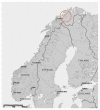Behavior in Avalanche Terrain: An Exploratory Study of Illegal Snowmobiling in Norway
- PMID: 35627575
- PMCID: PMC9140624
- DOI: 10.3390/ijerph19106040
Behavior in Avalanche Terrain: An Exploratory Study of Illegal Snowmobiling in Norway
Abstract
Snowmobilers make a grim and significant contribution to avalanche fatality statistics in Norway. However, there is limited knowledge on the behavior of this group in avalanche terrain and the factors influencing this behavior. Our study documents what snowmobilers do and not do in avalanche terrain, how their behavior relates to managing complex avalanche conditions and if there is a mismatch between avalanche competence, education and riding preferences. This ethnographic study observed snowmobiler tracks and thus avalanche terrain usage in Northern Norway during 2018 and 2019, supported by open-ended conversations with target group riders. Results show that high-marking lost popularity to technical riding, which seems to be perceived as safer despite increased exposure to complex avalanche terrain and conditions with persistent weak layers in the snowpack. The detected mismatch between preferences and avalanche knowledge/attitude will remain an obstacle to future accident prevention efforts unless behavioral changes are addressed. This study of a predominantly illegal activity sheds light on how to explore and observe hard-to-reach illegal activities and should be of interest to a wider audience from other research disciplines.
Keywords: avalanche education; illegal; persistent weak layers; qualitative method; snowmobiling.
Conflict of interest statement
The authors declare no conflict of interest.
Figures




References
-
- Avalanche Canada Annual Reports. [(accessed on 15 November 2021)]. Available online: https://www.avalanche.ca/about#annual-reports.
-
- NGI Snoskred.no. [(accessed on 27 February 2022)]. Available online: https://www.ngi.no/Tjenester/Fagekspertise/Snoeskred/snoskred.no2/Snoesk....
-
- Avalanche.org » Accidents. [(accessed on 25 February 2022)]. Available online: https://avalanche.org/avalanche-accidents/
-
- Techel F., Jarry F., Kronthaler G., Mitterer S., Nairz P., Pavšek M., Valt M., Darms G. Avalanche Fatalities in the European Alps: Long-Term Trends and Statistics. Geogr. Helv. 2016;71:147–159. doi: 10.5194/gh-71-147-2016. - DOI
-
- Mannberg A., Hendrikx J., Landrø M., Ahrland Stefan M. Who’s at Risk in the Backcountry? Effects of Individual Characteristics on Hypothetical Terrain Choices. J. Environ. Psychol. 2018;59:46–53. doi: 10.1016/j.jenvp.2018.08.004. - DOI
Publication types
MeSH terms
LinkOut - more resources
Full Text Sources

